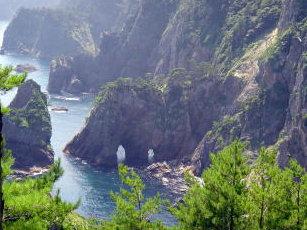|
The Riasu (or Saw-tooth) Sanriku Coastline is a raised coastline of 600km in total that spreads out from southeast of the Aomori Prefecture through the coast of the Iwate Prefecture to Ojika Peninsula in Miyagi Prefecture. Sanriku (or three riku) is a generic term referring to Mutsu in Aomori, Rikuchuu in Aomori and Rikuzen in Miyagi. The Riasu coast is a jagged stretch of coastline that consists of many long, narrow coastal inlets which uniformly cut into the coastal lands creating the appearance of saw teeth.
Offshore at the Sanriku coast is where the Okhotsk current (Oyashio) , a cold current, and the Japan Current (Kuroshio), a warm current, meet, creating a rich fishing spot that is considered to be one of the Four Great Fishing Grounds in the world.
The precipitous cliffs of the Sanriku coast are also an ideal breeding ground for wild birds such as osprey, Japanese cormorant and black-tailed gull.
Along the Riasu Sanriku Coastline there are many spectacular vistas created by the raging waves and rain storms of the Pacific Ocean.
| [+ADDRESS] | 
|


















